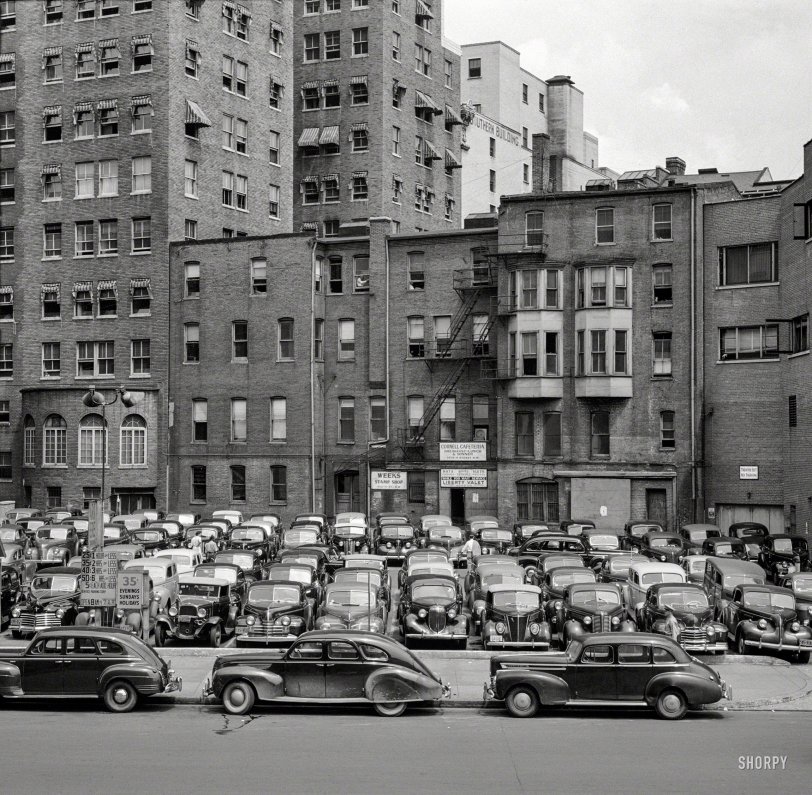


Framed or unframed, desk size to sofa size, printed by us in Arizona and Alabama since 2007. Explore now.
Shorpy is funded by you. Patreon contributors get an ad-free experience.
Learn more.

- Heckuva remote control!
- Sometimes — Things Go Bump!
- I SEE THE LIGHT
- Union Switch and Signal Company
- Get That Light Out Of My Eyes
- Eggs. Eggs. Eggs. The Egg Man is Here!
- Foreboding caption
- Famous Hollywood faces
- Not just S&P
- re: Those things in the jar
- Up In Smoke
- Medical Smoking
- Quick fix
- A Quink Comment
- If You’re Like Me, Never
- Delivering the News
- U.S.A.
- S&P
- 1940 Zenith radio model 6G601
- Quality goes in before the name goes on!
- Snazzy skirt
- Carbon Arc Lamps
- Illuminate us
- I remember it well
- I can't prove it
- Complicated then, forgotten now
- Bryan-Stevenson
- Skinny is as skinny does
- How do you rest in peace
- Riding the footboards
Print Emporium
Parked for the Duration: 1942

1942. "Effect of gasoline shortage in Washington, D.C." Medium format nitrate negative by Albert Freeman for the Office of War Information. View full size.
Parked for 9 or 10 Hours?
I think these cars have only been parked for the work day. Too many of them have open windows to have been parked for the duration of WWII. Along with many open door vent windows there are several cars with open hood vents that surely would have been closed if this was a long-term storage lot. The location, in the heart of D.C., also seems like a strange place to locate a place to store cars for a lengthy period of time. I think the photographer's caption is erroneous or someone else mislabeled the photo.
[The caption comes from the LOC catalog card for a collection of negatives mainly depicting parked cars in a variety of situations about Washington, D.C. -tterrace]
The car parked front and center is actually a 1938 Lincoln-Zephyr, not a 1941 model. The two most easily identifying features are the comet tail trim on the side of the hood and the exposed running boards. In 1939, all the way through the 1942 model year when the last Lincoln-Zephyr was built, the running boards were concealed by the doors on Lincoln-Zephyrs. The Zephyr name was dropped when Lincoln production resumed after WWII, but the same basic models continued in production.
Parked in front of the Lincoln-Zephyr is a 1941 Plymouth, and parked behind it is a 1941 Hudson Commodore Eight.
From left to right, parked in the front row, are these cars: 1941 Chrysler; 1936 Plymouth; 1932 Chevrolet; 1940 Oldsmobile; 1941 Dodge; 1938 Plymouth; 1937 Ford; 1938 Buick; 1941 Oldsmobile; and a 1939 Buick.
No SUVs or trucks are in the lot, but there is one 1938 Ford Station Wagon, Type 790, behind the 1939 Buick. The Station Wagon was marketed as a passenger car for the first time, but also continued to be sold as a commercial model. To lighten the tailgate the spare tire was stored inside the vehicle behind the driver's seat.
I am drooling...
I wish I could select even one of those beauties.. ok, let's say two! American cars made around 1940 really appeal my eye. They simply look like cars.
Parking fees
I know I am from a different age and country for that matter, but are the parking fees a little expensive for that time?
Spotted for the Duration
I recognize a number of the cars in the lot, numerous Buicks, Oldsmobiles, Fords, Dodges, etc., but for now I'll just highlight that 1938 Lincoln Zephyr front and center in the parallel-parked row. It could stand a wash, but meanwhile reminds me of the similar 1941 Zephyr 4-door fastback my family drove during my earliest years. That car's wonderful streamlining has determined my aesthetic toward automobiles (and pretty much everything else) ever since then.
Progress
It is interesting to note how few years separate the little '32 Chevy from the rest of the modern iron in the lot. It still has styling cues from the twenties. All the rest have streamlined bodies, pontoon fenders, big, powerful engines and so on. The late 30's was a period of huge automotive advances
The Trans-Lux Theatre
The "Theatre Exit, do not block" sign is for the Trans-Lux.. The Trans-Lux was at 14th and H Streets NW the screen end of the auditorium was behind the pictured doors. The Trans-Lux was torn down in 1974.
Spotter's Dream Come True!
Who going to name all the cars in this photo?
Whereabouts
This is the 1400 block of New York Avenue NW, looking north. Behind the lot are the rear of the buildings fronting on H St. These include 1416 H St. NW & its distinctive rounded bay, seen below in the 1921 Baist Atlas.
At center top, note the back (eastern facade) of the Southern Building, 805 15th St. NW.
























On Shorpy:
Today’s Top 5